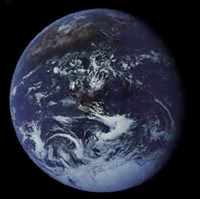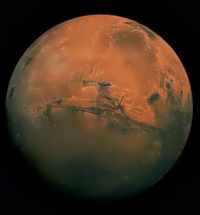|
Orbits
Orbit: The curved path followed by something such as a heavenly body or spacecraft in its motion around another body. Collins English Dictionary, 1999
 
Both Earth and Mars orbit the Sun. They are planets, and accompany seven others which also go around the Sun. The Sun is a star, a large ball of hydrogen gas which is turning into helium gas by a process known as thermo-nuclear fusion, which causes the Sun to be very very hot.
The Sun and its nine planets are known as the Solar System. Earth is the third planet and Mars the fourth. It takes the Earth just over 365 days to orbit the Sun. Mars takes just under 687 days. Earth therefore passes Mars about once every 26 months, as its orbital speed or rotation is quicker.
In order for something like a spacecraft to orbit a planet it must be going fast enough. To orbit Earth you need to travel at around 40,000 kph (25,000 mph), while to orbit Mars you only need to go at 18,000 kph (11,250 mph).
ORBITAL TRACK
Why is this, and why do things orbit in any case?
Lets answer the second point first. The simple answer is gravity. You know about gravity. Even babies discover gravity when they are very young. They like to play with it by dropping things.
So gravity makes things fall when you let them go. Gravity is a force. It is a push or a pull. When you push your friends, or pull their arms you are using force. Not too much we don't want anyone hurt! You can feel the effects of force.
We will come back to FORCE in a moment, because it is very important if we want to understand our world and indeed the whole Universe.
So what about orbits, then?
An orbit occurs when something such as a spacecraft is caught in the gravity of a planet, moon or star and it goes round and round it. To do this it must be travelling fast enough. If it goes too slow it will simply plunge down towards the planet (or whatever) and crash, leaving a big hole, we call a crater. You can see lots of craters on the Moon, just with your eyes. This is where comets, meteorites and asteroids (not spacecraft) have crashed into it.
But surely some of these natural space-travellers go faster than man-made spacecraft, so why don't they orbit the Moon?
Yes they do, but they are not going in the right direction to orbit. To orbit you need to be going in exactly the right direction too. Get it slightly wrong - either speed or direction - and you fly off into space, or you come crashing down!
What is the right direction and speed to orbit?
Direction is always the same - parallel to the surface of the planet, directly below you.
Speed varies with the mass and size of the planet and with the distance you are above the surface.
Basically, when you orbit you are in free fall, much as you would be if you suddenly found yourself completely still somewhere above a planet (The stillness wouldn't last long, I might add - you would immediately go plummeting towards the surface). Obviously, the gravity of the planet pulls you down, and you move down (whatever the circumstances), but if you have forward motion you move in a big curve. To orbit, that big curve needs to be the same size as the curvature of the planet.
As you travel, you are effectively dropping the whole time, but as you do so the ground curves away from you at the same rate. You never reach it, and in fact you never get any closer to it either.
This is called ORBITING.
But some orbitting spacecraft do fall back to earth, why is this?
It is because the Earth's atmosphere goes a long way out into space, and even though it is very thin it still affects the speed of the spacecraft. It slows it through a force we call aerodynamic DRAG.
I told you we would come back to forces.
FORCES
So tell me more - you said I can feel force. What about Gravity?
Let me ask you something: When you sit do you feel anything, anywhere? Yes, of course you do.
You feel the FORCE of the chair on your bottom. Gravity is responsible for this.
Are there any other forces?
Yes lots. They are everywhere. You produce forces thought using your muscels. Cars produce forces to move along. The sea produces forces when the waves break on the beach. The wind produces forces when it blows and bends the trees. Forces make the world work - literally.
Tell me more about forces
For a more complete explanation go to Newton's Motions.
Back to Mars Journey
|













